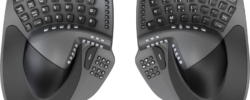The computer mouse has evolved over the last five decades. The bulky first mouse that was anything but dynamic was replaced by the mechanical mouse in the eighties, then came the wheel mouse with the scroll in the middle in mid nineties and then came the wireless mouse after the turn of the century. Alongside this evolution we had the inception of track-pads or touch-pads. Now, we have the projection mouse, the first of its kind, ODiN.
Inspired by the Norse God ODiN, more popularly known as the father of comic book favorite hammer wielding Thor, the projection mouse is a tiny but powerful device. In simple words, the ODiN is a small projector that uses laser beam to draw or to cast a layout which will act as the mouse or touch-pad to be more precise literally. ODiN is 5 cm tall and 4 cm broad. That is in contrast with the typical 12 cm tall mouse. ODiN takes a very tiny space next to your desktop or laptop which could be Windows or Mac, and it spreads a rectangular layout which looks like a floppy but with lines that would make you recollect the good old mechanical mouse. This layout is basically your mouse or touch-pad. You can use it just as you would use any track-pad or touch-pad, mostly available in laptops.
The projection mouse is capable of multi-touch controls such as zooming in or out but that is no revelation as laptops released five or seven years back also had such a feature. The only difference is that this time it is working by the virtue of laser projection and not by touch sensors. The projection mouse is certainly a cool gadget and it does away with the woes of the typical mouse.
ODiN will do away with all the pain and tiredness your hand is subjected to. By having your hand laid out normally on the table, you can avoid wrist pain and can also avert the risks of carpal tunnel syndrome. While these benefits and the technology do get the deserved attention, the practical utility and its durability will be put to test once the product rolls out. Right now, those are within the ambit of speculation and anticipation. The unit is portable and can be carried around easily. Also, it is a cool device for gamers. But in the real world, things might be just a tad different. A major challenge for the designers would be to ensure responsiveness and zero latency.















